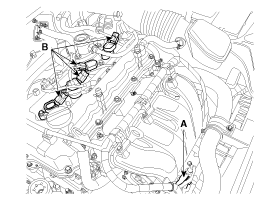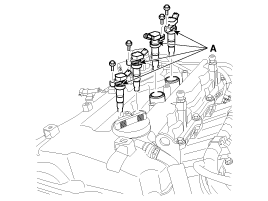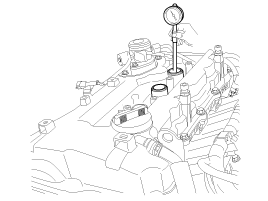 Kia Sportage: Compression Test
Kia Sportage: Compression Test
Third generation SL (2010ŌĆō2016) / Kia Sportage SL Service & Repair Manual / Engine Mechanical System / Compression Test
| Compression Pressure Inspection |
If the there is lack of power, excessive oil consumption or poor fuel economy, measure the compression pressure. |
| 1. |
Warm up and stop engine.
Allow the engine to warm up to normal operating temperature. |
| 2. |
Disconnect the injector extension connector (A) and ignition coil connectors (B).
|
| 3. |
Remove ignition coils (A).
|
| 4. |
Remove spark plugs.
Using a 16mm plug wrench, remove the 4 spark plugs. |
| 5. |
Check cylinder compression pressure.
|
| 6. |
Reinstall spark plugs. |
| 7. |
Install ignition coils. |
| 8. |
Connect the injector extension connector and ignition coil connectors. |
| 9. |
Some DTC''s may exist after the inspection test and may need to be manually cleared with GDS. |
 Specifications
Specifications
Specifications
DescriptionSpecificationsLimitGeneralTypeIn-line, DOHC?Number of cylinders4?Bore86mm (3.385in.)?Stroke86mm (3.385in.)?Total displacement1998cc (121.92cu.in)?Compression ratio9.5 ┬▒ ...
 Troubleshooting
Troubleshooting
Troubleshooting
SymptionSuspect areaRemedyEngine misfire with abnormal internal lower engine noises.Worn crankshaft bearingsLoose or out of specification engine flywheelReplace the crankshaft and ...
Other Information:
Power Window Switch: Repair procedures
Inspection
Main Power Window Switch Inspection
1.
Disconnect the negative (-) battery terminal.
2.
Remove the front door trim and power window switch.
(Refer to the BD group - "Front door") ...
Hazard warning flasher
The hazard warning flasher serves as a warning to other drivers to exercise extreme
caution when approaching, overtaking, or passing your vehicle.
It should be used whenever emergency repairs are ...
Categories
- Home
- Kia Sportage QL (2015-2019) Owners Manual
- Kia Sportage QL (2015-2019) Service Manual
- Kia Sportage SL 2010-2016 Owners Manual
- Kia Sportage SL 2010-2016 Service Manual
Copyright ® www.kispmanual.com 2014-2025




